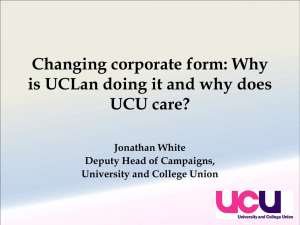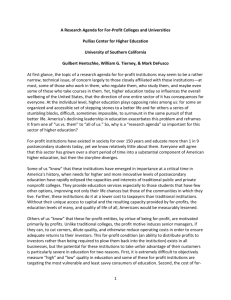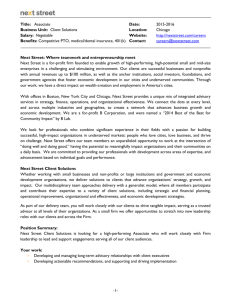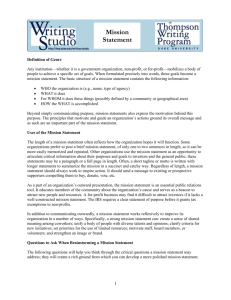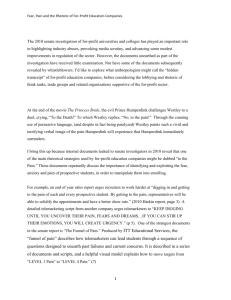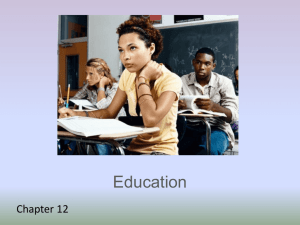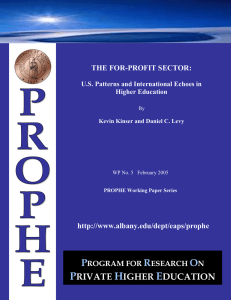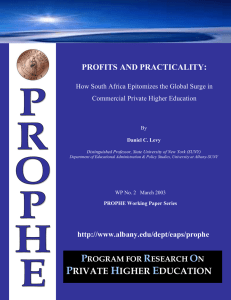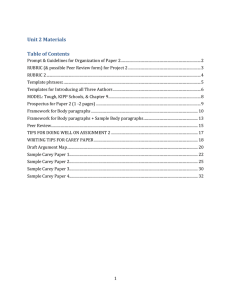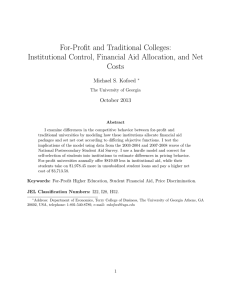For-Profit Higher Education in the United States
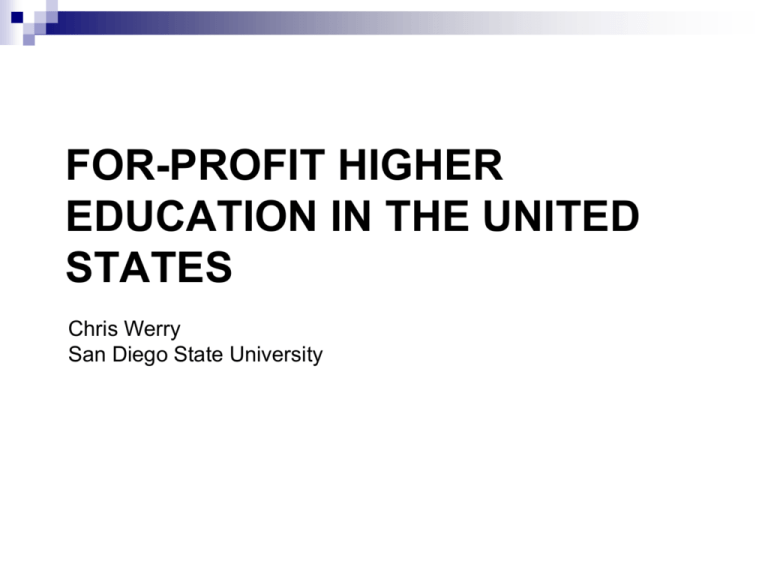
FOR-PROFIT HIGHER EDUCATION IN THE UNITED STATES
Chris Werry San Diego State University
( Documents from the 2010 Senate Investigation of the for-profit higher education sector ) Internal report analyzing recruitment rate at a for profit university (from 2010 Senate inquiry). Note how it urges recruiters to do a better job of “getting to the pain.”
The Funnel of Pain (from telemarketing script)
While ~9% of students are enrolled in for profits…
They account for 47% of all student loan defaults (student loans ~ 1 trillion $)
They receive 25% of government grants and loans.
At some of the largest publicly traded companies, 60% of students drop out, with the average around 50%.
The sector has enormously high dropout rates (“Churn and burn”)
Senate Inquiry findings
Most for-profits receive 90% of their revenue from public funds For-profits are among the most profitable companies in the U.S.
Many spend ~ 50% of their budget on marketing, recruitment and advertising.
They have been the subject of repeated lawsuits and investigations over their recruitment practices, promises of job placement, claims about accreditation and course transfer.
Eisman’s senate testimony
"With billboards lining the poorest neighborhoods in America and recruiters trolling casinos and homeless shelters —and I mean that literally—the for-profits have become increasingly adept at pitching the dream of a better life and higher earnings to the most vulnerable…The government, the students, and the taxpayer bear all the risk and the for-profit industry reaps all the rewards. This is similar to the subprime mortgage sector….If nothing is done, we are on the cusp of a new social disaster” Stephen Eisman
Introducing Project Rose
David Pauldine DeVry University Bob Cohen CCA
INTRODUCING PROJECT ROSE "Reframing is changing the way the public sees the world. It is changing what counts as common sense. " --George Lakoff , Don’t Think of an Elephant!
HOW OTHERS THINK ABOUT US
The Critic’s For-Profit Education “Frame”
• Basic Function is to Produce Profits • Education Yoked to the Purpose of Profits • Education at Odds (if not War) with Tradition • Mission is Anti-Intellectual and Common • Lead by Business People Not Educators • Targeting Most Vulnerable in Society • Lacking in Prestige and Demonstrable Value
HOW WE TALK
OLD
Brands Parent Company Employees Piece of business Sales/Telemarketing Leads Quotas Market Presence Starts Call Center Close For Profit/Private Equity Commissions
NEW
Institutions University System Faculty and staff Applicant Recruitment Inquiries Goals Regional Campuses New students Enrollment Assistance Center Finalize Private Sector Salary Component
U.S. University/College Names – major patterns
Most public universities and colleges are named after the state, state region, or city they serve. (University of California Los Angeles; Ohio State University; City University of New York, etc.)
Most private, non-profit
universities are named after the name of a founder (Harvard, Stanford, Carnegie Mellon) or a place (Princeton, Dartmouth). These names often have colonial era connotations (esp. older institutions).
Private, religious universities
and colleges are named after religious leaders/figures and locations (Point Loma Nazarene; Notre Dame; Loyola; Texas Christian University) Private for-profits used to have names that suggested careers, business, connection to a company, or contained words like “institute,” or “academy.” Now they feature names that appear to hide their for profit status and replicate naming practices of public and non-profit privates.
W hat’s in a name?
POP QUIZ: Which is a) public, b) private non profit, c) private for-profit?
1. Sylvan Learning Systems Inc.
2. American Career College 3. American Public University 4. Ashford University (was Franciscan Plains U) 5. University of the Rockies 6. Walden University
Using public names to mislead
“Students were not at all receptive to the calls as they couldn’t understand why they were being called by College.us.com, a Vantage Media website, and not the community college they thought they sent their inquiry to…the student never does
hear from the community college they had wanted information from in the first place.”
“Vantage Media is deceiving possibly two to three
thousand students a week. Students are being
misinformed. Public school reputations are being damaged. This is simply wrong and needs to be stopped.” “The whole Vantage Media lead generation model puts the student’s education path at risk.” (Whistleblower James Soloway, who worked at a Vantage Media call center, & filed a complaint with the Federal Trade Commission)
Mapping Networks of Influence
“We agree that for-profits are more accurately characterized as beneficiaries - rather than drivers - of change. However, there is one arena in which we suggest for-profit higher education providers and other corporations involved in postsecondary provision do have a very real chance of altering the postsecondary landscape. It is in
the political arena, through the use of lobbying and direct campaign contributions to shape regulations and policies that for-profits may ultimately prove to be of the greatest significance.
” Pusser and Walcott “Politics, Lobbyists, and the Transformation of Postsecondary Education” (2003)
Blackboard Inc. “Unlocking the Global Education Imperative: Core Challenges and Critical Responses” Reviews existing scholarship on higher education produced by government and by universities, and deemed it ‘insufficient’ (2).
Blackboard is “ideally positioned” to function as an agent “for major change in higher education.”
Mr Smith's Modest Proposal
■ CEO Burck Smith suggests it is useful to think of a writing program “like a customer service
center
.” ■ He argues that the practices of quality control, monitoring, assessment, tracking and recording make these online courses superior to traditional classes – they ensure transparency, accountability, and consistency, and enable ongoing assessment.
The rhetorical shaping higher education policy from 1995 to 2010
How organizations have used language to shape policy, and advance arguments about the need to a) restructure higher education, b) make changes to pedagogy, institutional organization, and labor conditions, and c) redefine key terms such as ‘democracy,’ ‘choice,’ ‘access,’ ‘participation,’ and ‘literacy.’ Focus is on government reports such as the National Educational Technology Plan and the Spellings Report (Commission on the Future of Higher Education)
1999: Widespread confidence that universities will be “Amazoned”
1999: the high water mark for plans to restructure higher education in the U.S.
“Thirty years from now big university campuses will be relics. Universities won’t survive. It’s as large a change as when we first got the printed book.” Management Guru Peter Drucker. “You guys are in trouble and we are going to eat your lunch” Michael Milken, 1999.
“Education over the Internet is going to be so big it is going to make e mail usage look like a rounding error.” John Chambers CEO of Cisco Systems, (1999).
"In future years we will look upon the wired remains of our once great democratic higher education system and wonder how we let it happen." David Noble, 1999.
After 1999: broad shifts in rhetoric
Tactical de-emphasis on the corporation as the ideal for educational restructuring The association of online education with the principles of access, diversity, democratization, participation, accountability and transparency, and “traditional” public education with their opposite Legitimizing the for-profit sector by minimizing the differences between for profits and public universities, and between online and campus-based education. “As higher education evolves, the new landscape demands innovation and flexibility from the institutions that serve the nation’s learners…In this consumer-driven environment, students increasingly care little about the
distinctions that sometimes preoccupy the academic establishment, from whether a college has for-profit or nonprofit status to whether its classes are offered online or in brick-and-mortar buildings
.” (2006 Commission on the Future of Higher Education)
After 1999: broad shifts in rhetoric
Faculty are demonized. Resistance to privatization, outsourcing, and de-professionalization/casualization of academic labor is defined as obstructionism, or elitist hostility to the needs of students.
“The Future & its Enemies” (ALEC) or “Catching up to our students and the future” (Educational Technology Plan) “Education is the only business still debating the usefulness of technology” Rod Paige, secretary of education (ETP, 2004) The push to restructure higher education is “ventriloquized” represented as coming from the demands of technology and a new generation of tech-savvy students.
“Toward a new golden age in American education: how the internet and today’s students are revolutionizing education.” Title of the government’s 2004 Educational Technology Plan.
What technology demands…
“Real technological change outsources work to distant locations, allows students and money to leave, substitutes capital for labor, and in other ways disrupts the existing job structure [of teaching].
Technology has a far-reaching capacity to transform politics. As distance learning proliferates, for example, teachers will be less geographically concentrated in districts, considerably more dispersed, and much more difficult for unions to organize .” John Chubb of Edison Schools and Stanford University political scientist Terry Moe authors of
Politics, Markets, and America’s
Schools and Liberating Learning: Technology, Politics, and the
Future of American Education
Crisis Rhetoric
“Tight Budget? Think Disruptively! Turnkey Courses from StraighterLine."
Higher education is in the throes of a perfect storm -
budget cuts, surging enrollments, lower endowments, increased competition and needier
students. Just trimming expenses wont make ends meet and will undermine educational quality. With StraighterLine’s ready-made, ready-staffed, ready-to-go developmental and general education courses, colleges can increase revenue by serving more students without having to build additional capacity” Burck Smith: “This is an opportunity to rethink the components and functions of a school and all of the political, economic, and accountability structures that surround it.”
Differences between 1999 and 2012
Focus on high –end versus “low-end.” Idea of replicating great schools, versus idea of starting at “bottom” and eating up the chain .
There are continuities in the rhetoric, but also some key differences. For example, arguments for restructuring have modulated calls for corporatization (there's more talk of democracy, transparency, consumer rights, accountability, diversity, access, etc.) The “crisis” rhetoric has changed The collapse of the internet bubble in 2000 was milder and set back many online education projects – both silly projects launched by universities out of fear, and plans to restructure higher ed. Current crisis is more severe, and may accelerate them.
“I worked as an Enrollment Counselor at GCU as well. The pressure to enroll anybody was very high. Our jobs were threatened if we didn’t hit our enrollment quotas .” “i almost ended up going to UOPx and the thing that stopped me was when all of a sudden i got a letter from Apollo stating that I qualified for this x amount of money for school and that they were going to disburse it on this date but I never gave UOPx my “yes” and the enrollment advisor was really pushy and knew how to play with my emotions…very good sales tactic for UOPx. very shady as well.” “Having worked for several years as a teacher at one of these for-profit colleges, I can attest to the practice of fraud and the unfortunate preying upon the students who enroll. Disgusted at the lies these students were told —not just in tv commercials but also by sales reps (oops! I mean admissions counselors), I became subversive and gave students assignments that required their investigating their chosen vocation and interviewing potential employers. Too many students thought that becoming a medical assistant was a first step to becoming a doctor and that salaries were on average 50k! One student found out that most pharmacy techs were trained internally, and there was no need to pay for a $25,000, 2 year training program !”
